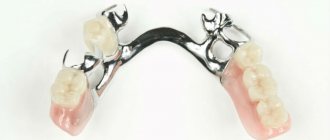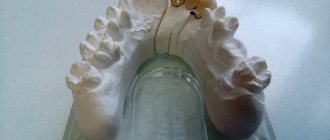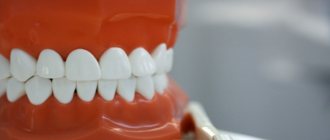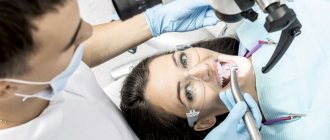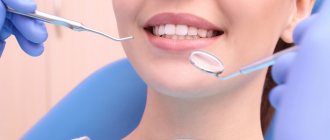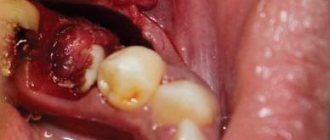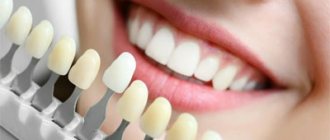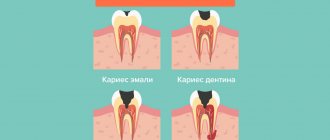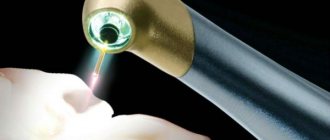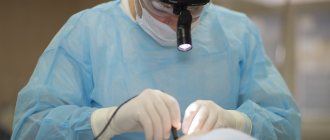Some people have developmental defects in the dentition and maxillofacial skeleton. Such complications arise in childhood, when teeth are just beginning to form. If there are problems in the development of the dentition, it is quite problematic to properly care for the oral cavity. Problems also arise during meals, as the jaw muscles are stressed, which leads to throbbing headaches. Let's find out what orthodontics is and how dentists carry out the treatment procedure.
How is the treatment method chosen?
During the consultation, the problem is initially identified, the necessary clinical data is collected in the form of impressions for diagnostic models, photographs of the face and teeth, and x-rays.
During a visual examination of the patient, the orthodontist identifies a type of anomaly in the position of the teeth and jaws. Then x-ray diagnostics are carried out (panoramic photographs of the jaws and tele-radiography of the head), taking impressions of the dentition and photographing the patient in profile and from the front. Based on the obtained models and the results of X-ray images stored in a special computer program, the doctor determines the causes of anomalies in the position of the teeth and the development of the jaws. Using photography, the impact of this anomaly on facial aesthetics is assessed. After this, the specialist draws up an individual treatment plan, selecting the design of the device and calculating the timing and cost of treatment.
We attach great importance to the future aesthetics of the face and smile, therefore when planning your treatment we consider the most important:
- Preserve the greatest number of teeth; we do not support treatment options that involve preliminary tooth extraction
- Restore the correct function of the corresponding groups of teeth, not limited to banal teeth alignment
- Offer the most comfortable type of orthodontic mechanics; during treatment in our clinic you will have unlimited medical support
- Offer the most convenient and at the same time the most effective equipment
- Use modern treatment technologies: mini-implants, removable transparent Invisalign aligners, Incognito lingual braces
- Carry out mandatory regular hygiene support
- Ensure strict management of the retention period. We are responsible for maintaining your treatment results, therefore, after removing the equipment, the following are required: fixation of retainers and periodic control visits throughout the year.
Dangers of malocclusion
It would seem like a small thing: the teeth protrude slightly or do not close together. But the human body is a single apparatus. Improper functioning of one part leads to failures in others. The dental system is involved in the process of chewing, breathing, swallowing and speech.
Breath
Pathologies of the jaws lead to the fact that a person begins to breathe through the mouth. In children, this leads to insufficient lung volume and frequent diseases of the upper respiratory tract.
When breathing through the mouth, less oxygen enters the lungs, and the chemical composition of the blood changes. This leads to the development of pulmonary and cardiovascular diseases.
Chewing
With a correct bite, the chewing load is distributed evenly. If the occlusion is incorrect, some teeth are excluded from the process, and the remaining ones are subject to additional stress. This leads to tooth decay and periodontal disease. Also, improper load when chewing eliminates some of the muscles, which can provoke problems with the TMJ (maxillary joint)
Swallowing
One of the functions of the tongue is to push food from the mouth into the larynx and beyond. With an incorrect bite, the tongue is positioned incorrectly in the mouth, resting not on the palate, but on the teeth. Due to this, it does not work at full strength, is placed between the teeth, and complicates the orthodontic situation in the mouth.
Speech
With abnormal occlusion, pronunciation suffers the most. The child cannot pronounce some sounds, swallows them, and replaces them with others. It is difficult to understand such children; their diction is impaired and their speech is unintelligible.
During a conversation, certain muscle groups work. With pathologies, some of them are switched off from the process, others are overexerted. This can lead to facial asymmetry.
Posture
Relatively recently, doctors began to pay attention to the relationship between bite and posture. An incorrect bite affects the position of the head. And this, in turn, shifts the center of gravity. The load on the spine changes and back problems, scoliosis and other troubles appear.
Treatment for adults
Treatment of adult patients is work within the framework of an already established dental system, with long-established problems, ingrained habits of movements of the lower jaw and the temporomandibular joint. Moving teeth in such conditions is aimed at restoring lost harmony, creating better conditions for further prosthetics or implantation and achieving the most long-term results. This is always the work of several specialists: an orthodontist, a surgeon and an orthopedist, in which it is the orthodontist who plans the stages of each doctor’s intervention. To ensure predicted results and their interaction, it is necessary to undergo a consultation and diagnosis procedure with an orthodontist.
Bracket systems
After the process of changing teeth, as well as in adulthood, non-removable orthodontic equipment (brackets system) is used, which are special locks that are fixed with enamel-safe composite material on the outer or inner surface of the teeth. Each bracket (lock) has a special groove into which an arch made of a special material that has shape memory is placed. That. the arc installed in the grooves tends to the correct position. Braces are made from a variety of materials, depending on the wishes of the patient. They can even be completely transparent (sapphire braces).
The French Dental Clinic uses Dr. Ricketts' method, which, according to French orthodontists, is today the most advanced and most effective of all existing methods of orthodontic treatment. The method is a bioprogressive technology with a lighter load, which allows you to increase the time between supervised visits to patients up to 6 weeks (instead of the usual two). This is the optimal time during which the maximum effect of tooth movement between the activation and rest phases is achieved. Meanwhile, the duration of the treatment itself is significantly reduced.
Braces incognito
Some patients prefer to keep their treatment confidential. For them, we use the method of lingual fixation with Incognito equipment. That is, braces are installed on the inner surface of the teeth. Such braces will not be noticed by anyone around you, even with the widest smile. The French Dental Center uses special braces, custom-made according to individual impressions, which do not cause inconvenience during treatment and do not leave injuries or abrasions on the tongue.
Types of bite
Bite is the closure of the teeth of the upper and lower jaw. Orthodontists call it occlusion.
There are several parameters by which a bite is classified as correct or incorrect. When making a diagnosis, take into account:
- how much the upper teeth overlap the lower teeth;
- how teeth contact each other;
- at what angle they are located;
- presence of antagonists (teeth opposite);
- How is the central axis located?
When these indicators do not correspond to the norm, they speak of a malocclusion.
- Only 10% of the population has a correct bite, but most people have minor anomalies and do not pay attention to them. This leads to sad consequences. Malocclusion has a negative impact on the quality of life: the chewing load is distributed unevenly, difficulties arise with prosthetics, inflammatory processes develop in the periodontium, and posture is disturbed.
INCOGNITO braces
Paris
Michel Cassagne: specialist in working with the Incognito braces system.
ORTHODONTIST
Michel Cassagne is the only doctor in Moscow who has been trained in the USA to use Incognito braces.
Incognito is an elite bracket system, the leader in lingual orthodontics!
- Gold alloy does not cause allergies.
- Invisible. Fixed on the inside of the teeth.
- They are manufactured in the TOP-Service laboratory in Germany especially for you at the request of your orthodontist.
Learn more about INCOGNITO braces
Until recently, fixed appliances were the only type of orthodontic treatment for adult patients. The results of such treatment are impeccable, but have a number of negative aspects, for example: difficulty brushing teeth, exclusion of certain types of solid foods from the diet, changing the shape of the lips due to the volume of the braces themselves, breaking or peeling off the braces, etc.
Invisalign aligners
Today, all these moments can be avoided thanks to the newest Invisalign method. Its essence lies in the fact that, instead of braces and arches, invisible (transparent) aligners made from the patient’s impression are used. After scanning the resulting models, the sequence of teeth movement is simulated on a computer - step by step. For each step, a custom version of the mouthguard is made, which gradually moves the teeth into the correct position. For the entire period of treatment, there can be from 12 to 48 pieces of such mouthguards, depending on the effectiveness of the movement of the dentition.
The advantage is that the mouth guards can be removed while eating (eating preferences remain the same), are easy to clean, they are not visible, do not create additional volume and do not interfere with conversation. The duration of treatment with Invisalign does not increase compared to traditional treatment.
Of course, Invisalign is a product of technological progress, showing how comfortable modern treatment can be without losing its effectiveness!
Classification of bites
There are several classifications, but the most common one identifies the following types of bite:
- Neutral
(correct). - Distal.
The upper jaw is pushed forward. The teeth are either tilted forward, not adjacent to the lower jaw, or backward, tightly overlapping it. - Mesial.
The lower jaw protrudes forward. - Cross.
A pathology in which individual teeth in the lower jaw overlap the upper ones is called crossbite. - Open.
With an open bite, the antagonist teeth do not close together. - Deep.
The upper teeth cover half or more of the lower crown. It is interesting that such an anomaly occurs only in modern people; the ancients did not have it.
A - open, B - crossed, C - deep, D - mesial
INVISALIGN mouth guards
Paris
Michel Cassagne: specialist from France.
Orthodontist
Our orthodontist, Dr. Michel Cassagne, was one of the first orthodontists to use Invisalign. He has the most experience with them and appreciates their effectiveness and practicality.
Aligners and trays for moving teeth are the most advanced technology in orthodontics.
- Mouth guards are an innovative technology in orthodontics
- Completely invisible to others
- Absolutely comfortable to wear
- Easy to care for and maintain hygiene
- No restrictions on food
Is orthodontic appliance harmful to tooth enamel?
The cause of caries and inflammation of the gums - gingivitis - is dental plaque - a conglomerate of bacteria and food debris that constantly forms on the teeth. The presence of non-removable equipment significantly complicates self-cleaning of the oral cavity. The “immature” enamel of children and adolescents is especially susceptible to carious damage, and above all, the “risk zone” is the areas around the braces.
In this situation, following basic rules of home hygiene and the recommendations of an orthodontist completely eliminates the occurrence of complications such as the appearance of “white spots” on the enamel or carious lesions/cavities and makes orthodontic treatment safe for the patient’s teeth.
Damage to gums and enamel does not occur due to braces, but as a result of poor hygiene. At the beginning of treatment, in addition to recommendations for home hygiene, all patients receive a set of preventive services aimed at strengthening tooth enamel and preventing damage to teeth and gums.
The professionalism of the orthodontist, the competent choice of orthodontic apparatus and close cooperation with the patient are the keys to successful treatment!
Treatment of children and adolescents
Considering the physiological growth potential of the maxillofacial complex, orthodontic treatment is most effective and efficient in childhood. It is advisable to begin treatment at the age of 7-8-9 years, when the child’s teeth are actively changing, the alveolar process of the jaw and the entire maxillofacial complex are growing. The parafunctions of the muscles of the tongue, lips and cheeks are not yet completely fixed, and orthodontic equipment works together with natural physiology and allows you to simulate jaw growth in the desired direction.
To treat children with mixed dentition, active mechanical devices are used (for example, the Kvarda-Helix apparatus). Such devices change the size of the dental arches automatically, thanks to the activation of the equipment. The doctor regularly monitors intermediate results and makes corrections. During the period of mixed dentition, a partial braces system is also used to correct the incorrect position of existing permanent teeth.
If a child has a lag in the growth of the jaws or an advance in the development of one jaw in relation to another, the situation will be corrected with the help of two-jaw removable devices that move the jaws relative to each other, restraining or stimulating their growth. The optimal age for such treatment is from 5 to 8 years and from 10 to 12 years. Correcting the position of the jaws can improve the shape of the face.
This biological approach allows:
- Save all of the child's permanent teeth
- Form a harmonious facial profile due to the correct ratio of jaws and lips
- Correct in a timely manner factors harmful to the bite, such as mouth breathing, improper swallowing, flabby muscles of the lips and cheeks, and lack of space in the dentition for permanent teeth.
It is important to note that treatment in a growing body requires round-the-clock presence of the equipment in the patient’s oral cavity to ensure continuous impact on the growth of the alveolar processes, therefore we do not use removable devices in pediatric patients. Read more in the section “correction of bite in childhood”.
Causes of malocclusion
Internal causes include factors that influenced the child before his birth. These are hereditary factors, taking certain medications during pregnancy, and disruption of the endocrine glands.
Ecology, childhood diseases (rickets, etc.), bad habits (finger sucking) are external factors. This also includes an incorrectly selected pacifier when feeding from a bottle. With a large hole, the mixture easily pours out and the muscles do not train, disrupting the bite.
The best specialists from France
François Najjar: French Dental Clinic.
Chief physician, founder of FDC
Since 2004, the doors of the first exclusive French Dental Clinic in Russia have been opened for everyone who wants to have an appointment with famous specialists from Paris, Nice, Cannes, Sophia Antipolis, Lyon, Lille.
Specialists from all areas of dentistry were invited from different parts of France in order to undergo the most stringent selection. The choice fell on professionals with extensive experience of successful work and excellent recommendations.
— French Dental Clinic team
Frank Ajege
Periodontist-implantologist
Experience in surgical dentistry since 1987. Has a private clinic in Nice (France).
Michel Cassagne
Orthodontist
with over 30 years of experience in dentistry. Has a clinic in Paris, specializing in aesthetic orthodontics.
Didier Saada
Dentist
Experience in dentistry since 1988. Graduated from the Faculty of Surgical Dentistry at the Medical University in Marseille.
Reduced chewing efficiency due to lack of a chewing band
Before
Stages
After
Specialists:
Denisova Ekaterina Alexandrovna
The main complaint in this clinical case was reduced chewing efficiency due to the absence of almost the entire chewing group of teeth in the lower jaw.
During the preparatory stage before orthodontic treatment, bridge structures on the upper jaw were removed. The abutment teeth are covered with single composite crowns fixed using an adhesive protocol. The goal of orthodontic treatment was to prepare the dental system for subsequent rational prosthetics, guaranteeing long-term stability of the result. Implantation of missing teeth was carried out at the stage of orthodontic treatment, just like temporary prosthetics. After the braces were removed, all temporary structures were replaced with permanent ones.
